













Welcome to the spring edition of Chem@Cam. As I write, Cambridge is emerging into the glories of spring, with blossom on the trees, spring flowers under foot and buds beginning to break open on the trees. We have survived the Lent Term, which always seems like a struggle in the dark and the cold, but there was a real high point for us at the end of term when we opened our doors to the public for our annual Open Day.
Alongside the usual hands-on activities for our younger visitors was the much-anticipated return of one of Peter Wothers’ acclaimed demonstration lectures: Just Add Water. We welcomed a large group of alumni to the first lecture, followed by lunch. It was great to catch up with old friends and meet alumni and their families who have not visited us before. We plan to repeat this next year, so keep an eye out for an invitation in the winter Chem@Cam.
In this issue you can read about the careers of some of our Herchel Smith fellows after their time in the Department. These prestigious fellowships, endowed by this great Cambridge philanthropist, have been an important stepping stone for many researchers. We also have a feature about former members of the late Chris Abell’s group in which they talk about their experiences in Chris’ lab and their subsequent careers.
As always, you can catch up on news about our ground-breaking research and the latest awards and prizes. And for those with a competitive streak, we have a crossword set by our new puzzler, PhD student Loris Marcel.
I hope you enjoy this edition of Chem@Cam and please do keep in touch with your news and views.
 James Keeler Head of Department
James Keeler Head of Department

at Chemistry Open Day.
Chem@Cam
Yusuf Hamied Department of Chemistry University of Cambridge Lensfield Road Cambridge CB2 1EW
01223 763079
news@ch.cam.ac.uk
www.ch.cam.ac.uk
@ChemCambridge
Views expressed in this magazine are not necessarily those of the Editor, the Yusuf Hamied Department of Chemistry or the University of Cambridge.
Print: Precision
Chem@Cam is published twice a year, and is sent free to chemistry alumni, postdoctoral researchers, retired staff and friends of the department.
CONTRIBUTORS
Editor
Diane Harris
Contributor and design
Caroline Reid
Photography
Nathan Pitt
Michael Webb
Cover photo depicts Professor Peter Wothers
A symposium was held in April to mark the scientific contributions of Professor John Pyle, who has retired as the 1920 Chair in Physical Chemistry, and who was Head of Department from 2014 to 2018.
Many of John’s colleagues and former group members, who now hold prestigious positions across the world, returned to Cambridge to speak about John’s highly regarded atmospheric research and how it has influenced their own understanding of greenhouse gases and atmospheric modelling. Many also noted John’s continued commitment to the wider scientific community, including his role as one of the cochairs of the Scientific Assessment Panel that advises parties to the Montreal Protocol, the incredibly successful international agreement which regulates ozone-depleting substances, and which could be a model for future carbon-emission agreements.
The day of talks and reminiscences was followed by a dinner at St Catharine’s College.

Since its founding in 2012 by CEO James Harrison (Robinson 1992), Cycle Pharmaceuticals’ mission has been to improve the quality-of-life of rare disease patients and their carers by reducing the treatment burden.
Now Cycle has reached a new milestone: it has grown to become one of the top ten independent pharmaceutical companies headquartered in the UK, measured by sales.
Cycle provides treatments for people with rare metabolic, immunological and neurological genetic conditions, and James is particularly proud of the individualised patient support that goes along with these products. James says: “Cycle is helping patients every single day and they rely on our drugs to stay alive.”
To ensure Cycle’s treatments reach the people who need them, the company has established sales, distribution and patient support services teams in the US, while product launch teams, marketing,
product development and other functions are based in Cambridge. About half of its 120 employees are in the US, with the other half in Cambridge.
Cycle sold more than $100 million of drug products in 2023. Its most recent medicine, TASCENSO ODT for multiple sclerosis, was launched last year, and several new products are in the pipeline for 2024. Cycle provides its original NITYR drug product for free in more than 20 countries around the world.
James, who was named UK Changemaker in the EY Entrepreneur of the Year awards in December 2023, says: “The science is fundamental, but the best drug in the world only works if it’s being used. That’s why we are proud to have reached this milestone. We are also proud to continue to build a global business based here in the UK. It is always a shame to see businesses based on UK scientific research leave these shores so early in their business life.”

New post for Mary Garson
Alumna Mary Garson has been appointed Vice President of the International Union of Pure and Applied Chemistry (IUPAC) for 202425 and will become President in 2026-2027.
Mary will be only the third woman and the second Australian in IUPAC’s 104-year history to hold this international leadership position.
Mary writes: “The focus for my term of office is ensuring that IUPAC has a very strong scientific direction and is positioned as the leading international organisation within chemistry and chemistry-related policy matters.”
Mary completed her PhD with Professor Jim Staunton in 1977 and is now Professor Emerita of the School of Chemistry and Molecular Biosciences, University of Queensland.

array of awards
Professors Sir Shankar Balasubramanian and Sir David Klenerman have received three further prestigious awards for their pioneering DNA sequencing work.
In January they were inducted into the National Inventors Hall of Fame, which has recognised extraordinary innovators for over 50 years.
In April, they were honoured with the 2024 Novo Nordisk Prize, which recognises active scientists who have provided outstanding international contributions to advance medical science to benefit people’s lives.
With Dr Pascal Mayer they were also awarded the 2024 Canada Gairdner award for transformative contributions to research impacting human health.
The pair are recognised for their contributions to Next Generation DNA sequencing, which began in the late 90s, enabling fast, accurate and large-scale genome sequencing for the first time, transforming the worlds of medicine and biochemistry.
In 1998 they founded Solexa to develop and commercialise the new technology. Solexa was acquired by Illumina in 2007, who further developed the technology, which is now used in labs across the world.

Sparxell sparks funding success
Congratulations to Vignolini lab spinout Sparxell, which has completed a $3.2 million funding round to accelerate the development and commercialisation of its plant-based alternatives to toxic colourants.
Sparxell’s vibrant glitters, sequins and films contain no mica and no titania and are entirely biodegradable. They could eventually replace environmentally damaging synthetic chemicals in multi-billion dollar markets such as fashion, cosmetics, paint and packaging.
Dr Benjamin Droguet, who founded the company as a postdoctoral researcher in Professor Vignolini’s Bio-inspired Photonics research group and is now Sparxell’s CEO, says: “I spent countless hours nurturing a project first born in the Chemistry department which has now won the backing of distinguished funds and grants. I am thankful for the time, trust and advice of everyone who supported me and my team along the way to get here.”
Sparxell was honoured with the Biomimicry Institute’s Ray of Hope prize in 2023, which is awarded to the world’s top nature-inspired startup.

How could tiny antennae attached to tiny algae speed up the transition away from fossil fuels? This is one of the questions being studied by the Vignolini group as they search for new ways to decarbonise our energy supply, and improve the sustainability of harmful materials such as paints and dyes.
The Bio-inspired and Bionic materials for Enhanced Photosynthesis (BEEP) project, led by Professor Silvia Vignolini, studied how marine organisms interact with light.
The four-year sustainable energy project brought together nine research groups from across Europe and drew its inspiration from nature, in particular from the marine world, where organisms including algae, corals and sea slugs have evolved efficient ways to convert sunlight into energy. Harnessing these properties could help develop technology that incorporates photosynthesis, either artificially or by integrating biology.
Some of the brightest and most colourful materials in nature – such as peacock feathers, butterfly wings and opals – get their colour not from pigments or dyes, but from their internal structure alone. The colours our eyes perceive originate from the interaction between light and nanostructures at the surface of the material, which reflect certain wavelengths of light.
As part of the BEEP project, the Vignolini team studied structural colour in marine species. Some marine algae species have nanostructures in their cell walls that can transmit certain
wavelengths of visible light or change their structures to guide the light inside the cell. We don’t know a lot about the function of these structures, but scientists believe they might protect the organisms from UV light or optimise light-harvesting capabilities.
The team studied the optical properties and light-harvesting efficiency of a range of corals, sea slugs, microalgae and seaweeds. They hope to design new materials for bio-photoreactors and bionic systems by taking inspiration from these creatures.
“We’re fascinated by the optical effects performed by these organisms,” says
Maria Murace, who is doing her PhD in the Vignolini group studying structural colour in seaweeds and marine bacteria. “We want to understand what the structures at the base of these colours are, which could lead to sustainable alternatives to the paints and toxic dyes we use today.”
The BEEP team also studied diatoms: tiny photosynthetic algae that live in almost every aquatic system on Earth and produce as much as half of the oxygen we breathe. Their silica shells have stunning structures and remarkable light-harvesting properties.
The team engineered tiny lightharvesting antennae and attached them to diatom shells.
“These antennae allowed us to gather the light that would otherwise not be harvested by the organism, which is converted and used for photosynthesis,” says Cesar Vicente Garcia, one of the BEEP PhD students, from the University of Bari in Italy. “The result is promising: diatoms grow more! This research could inspire the design of powerful bio-photoreactors, or even better.”
The scientists also made a prototype bio-photoreactor, consisting of a hydrogel which nourishes microalgae and structural coloured bacteria. The organisms in the reactor interact in a mutually beneficial way, enhancing microalgal
growth and increasing the volume of biomass, which could have applications in the biofuel production industry.
Alongside research, the network has organised several training and outreach activities, including talks and exhibitions for the public at science festivals in Italy, France and the UK.
“Society relies on science to drive growth and progress,” says Floriana Misceo, who manages the Vignolini group and coordinated the BEEP project. “It’s so important for scientists to share their research and help support informed discussion and debate because without it misinformation can thrive, which is why training and outreach was an important part of this project.”
“Coordinating this project has been a great experience. I learned immensely from the other groups in BEEP and the young researchers,” says Silvia. “The opportunity to host researchers from different disciplines in the lab was instrumental in developing new skills and approaching problems from a different perspective.”


DrTessel Bouwens is an NWO Rubicon Fellow in the Reisner lab and a Junior Research Fellow at Darwin College. She is researching the use of artificial photosynthesis to develop synthetic medicines.
Could you tell us a bit about the focus of your research?
So I’m a chemist, first of all! And I focus on artificial photosynthesis. Basically, we’re trying to learn from nature where, for example, leaves on plants use sunlight to convert simple molecules like carbon dioxide and water into the building blocks of life.
Photosynthesis is perhaps the one process that even people who didn’t go very far with science remember from school.
Yes! And we’re trying to emulate that process, to find solutions and alternatives for what we now use fossil fuels for. To see if we can make, for example, solar fuels, where we don’t have the emissions of carbon dioxide. I am particularly looking into if we can also use the same kind of chemistry to not produce simple fuels, but more complex molecules like the building blocks for medicines.
It’s a bit of a stretch, it’s a new direction in artificial photosynthesis research, but it’s very exciting.
Wow! So how would that work?
So what we’re trying to do within artificial photosynthesis is we use light to break and make new chemical bonds. That works with very simple molecules like hydrogen – you just have to bring together electrons and protons. Now the big question is if we can also use the same principle to make more complex molecules. In principle it should work but of course it’s way more complicated. The devices I work on are called biohybrid devices, so we have synthetic parts as well as biological parts.
I was very happy that I could join this research group because they’re really leading in the whole field – there are so many different things being done and I really like that.
That’s extraordinary that you can take it in so many different channels.
Yes, I think that’s the beauty of chemistry. That’s what I really like about chemistry, that with the same principles you can get anything you want.
And how did you start? Were you always very science-focused in school or how did your pathway come about?
I was always very interested in the natural sciences but I first thought I wanted to study biology, because I really liked studying how cells operate. There were all these complex cascades of reactions going on, it really amazed me. But then in the end I found out that I actually really liked the chemistry behind that. I did a small project in high school where I made my first molecule and I was sold straight away. It was a very simple molecule but I just loved it.
Was there a stage in your studies when you realised that you wanted to carry on learning and researching?
Yes, during my first internship. At the University of Amsterdam, in your second year you do these four-week internships in a real research group. I loved being in the lab. I learned that you can use your fascination for a molecular bond to solve these important problems, like the energy crisis. And that was really the moment that showed me, ‘oh this is wonderful actually.’ Then I really wanted to become a researcher, to try to have an academic career.
Tessel was interviewed by Darwin College Communications Manager Laura Kenworthy for the International Day for Women and Girls in Science. This article has been reprinted from the Darwin website with their kind permission.

Have you felt at a disadvantage at any point, as a woman in science?
It’s really interesting; during my high school there was a specific programme encouraging girls to choose natural sciences subjects. It worked really well – I remember that I actually had a physics class with 25 girls and five boys. So I never felt that this is not a place where I should be. But now I’m at a later stage in my career I can really see for the first time that there is a difference in numbers. So I think it’s really important that people keep on investing in these kind of programmes, because I think they really work.
“Chemistry can help us to solve problems that we encounter today.”

Professor Peter Wothers returned to the spotlight this year for his first Chemistry Open Day demonstration lectures since lockdown.
Peter presented three entertaining talks throughout the day on the essential properties of water, illustrated by a variety of explosive experiments that the audience were told not to try at home!
For the first time this year, over 100 alumni and their guests had reserved seating at the first lecture, followed by a buffet lunch. Many brought their children and grandchildren, and stayed to explore the other hands-on activities going on throughout the day in the department.
Teaching technicians Tom Wilkins and Sarah Mitchell did a fantastic job preparing and helping in their first demonstration lecture, ably supported by final year undergraduates Cherie-Anne Shi Xian Lee and Agustin Lorusso Notaro Francesco.
“I am left with the challenge of explaining to a thrilled great-niece that University lectures won’t all be like Peter’s performance!”

“Please congratulate Peter on managing to excite, inform and entertain such a diverse audience!”

Chemistry Open Day has a range of activities designed for different ages from young children to sixth formers to adults. Students and researchers in the department volunteer their own time to devise and host games and activities that are not only engaging but also convey important scientific principles in areas from sustainable materials, better batteries, DNA, and just fun chemistry stuff like making ice cream using liquid nitrogen.
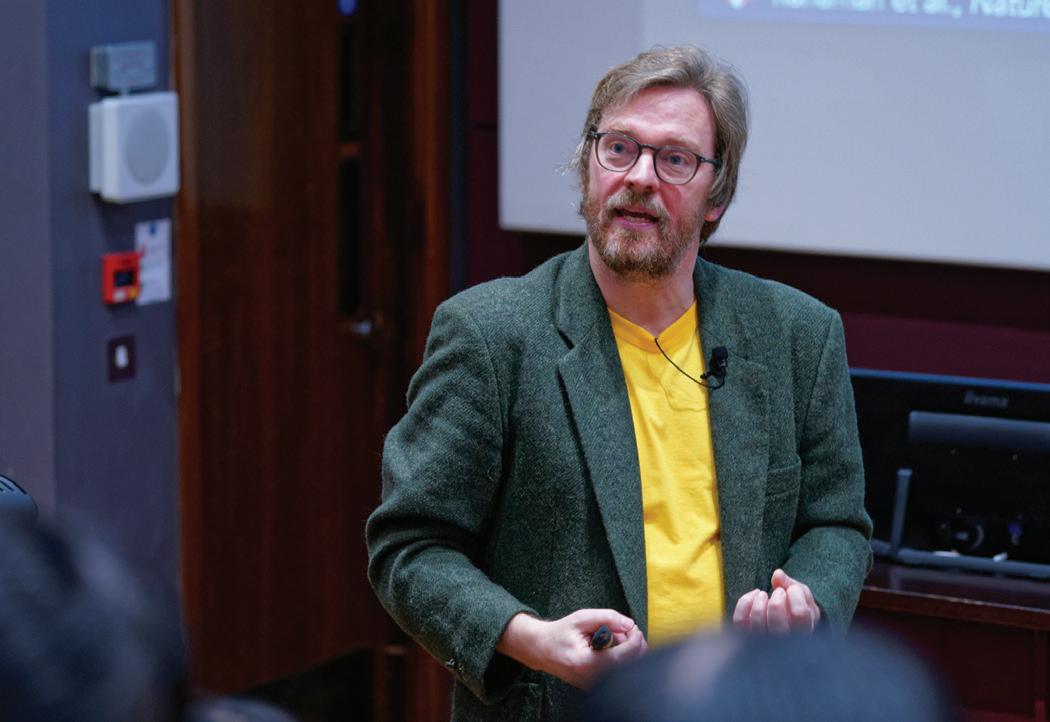
Another first this year was the inspiring lectures by Professor Erwin Reisner on how his group is developing ways to harness sunlight to turn carbon dioxide, biomass and plastic waste into the chemical resources we will need for a carbon-zero economy. Erwin, who was recently awarded a prestigious Royal Academy of Engineering Chair in Emerging Technologies, will make these lectures a regular feature of Chemistry Open Day.
Open Day organiser Emma Powney says: “It’s great if we can spark an interest in chemistry in the younger generation: we want to open their eyes to the possibilities of science.”
Building molecules at Open Day.Dr Herchel Smith completed his PhD in organic chemistry in this department under Professor Lord Alexander Todd in 1952. His subsequent research led to the first synthetic birth control pills, and when he died he left an extensive legacy to Cambridge, which laid the foundation for a number of professorships and fellowships in his name.
Herchel Smith postdoctoral fellowships offer outstanding young scientists three years of funding, a research allowance and a significant degree of independence.
Meet several fellows who have gone on to lead their own successful research groups, and one current fellow who started in October.

Itai joined the Nitschke group last October as a Herchel Smith postdoctoral fellow. He researches molecular photoswitches, which he incorporates into the structures of supramolecular cages so that the shape of the cages changes when exposed to light. “Cages that expand or contract their cavities with response to light can induce their guest molecules to undergo dramatic chemical transformations,” he says.
Itai is grateful to have the fellowship, saying: “I could only come here thanks to the wonderful financial support from the fellowship. Also, the associated research funds provide me with much-appreciated independence.”
Itai hopes to continue in academia and merge insights from his research here with experience from his PhD research in synthetic organic chemistry. “I’d like to work on fundamental problems in chemistry that have a tangible societal impact.”

Dr Ala Bunescu
After finishing her postdoc at UC Berkeley, Ala was looking for an academic position in Europe. “I realised that getting experience as a Herchel Smith scholar could help both my science and my career,” she says.
Ala joined the Gaunt group in 2018, where she developed an innovative and multifaceted project, using organometallic catalysis and photocatalysis. The new method enables streamlined access to structural motifs with high molecular complexity which are relevant to the Pharma industry, and ultimately aims to speed up the drug discovery process.
Having the fellowship made a big difference to Ala’s research and her career trajectory. “To have a Herchel Smith fellowship demonstrates independence in your thinking and your ability to write a proposal and attract funds. The three years of funding give you the peace of mind and time to do your research, and to wait for the right opportunity to come along.”
Ala now runs her own organic chemistry research group as a Junior Professor at the University of Bonn, where she is developing new strategies to enhance the sustainability of organic synthesis.
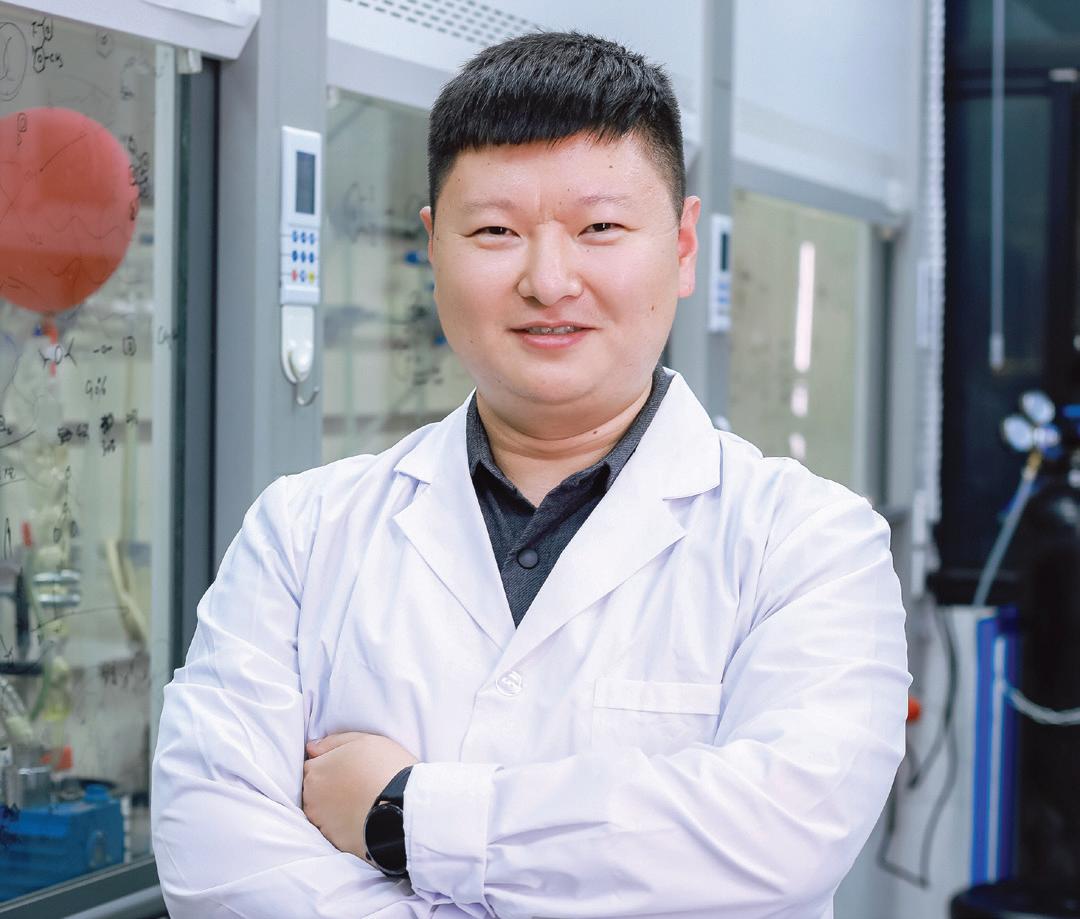
During his last year of PhD studies at the ENS-Lyon, Dawei had a six-month residency in the Nitschke group as a visiting PhD student. Dawei returned to the same group supported by the Herchel Smith fellowship in 2017. He says, “I am very interested in supramolecular chemistry, especially in cages, and Jonathan is one of the top chemists in this area. He published lots of interesting results and highquality papers, and it was a dream for me to join his group.”
In the Nitschke group Dawei worked on self-assembled metal-organic cage molecules. “We built a series of cage molecules for different purposes and applications. For instance, one of the cages we developed was capable of encapsulating polluted molecules, so we could use the cages to remove pollutants from water.”
When COVID-19 hit in 2020, the labs were closed and it wasn’t until June 2020 that the researchers were allowed to return on an every-other-day basis. As a result, Dawei’s fellowship was extended by six months. “I was very grateful for the extension and everyone was very supportive during the special period”, he says. “My three and half years in Cambridge allowed me to have fruitful results and publications, and was extremely important to my career.”
Now as Professor of Chemistry at East China Normal University in Shanghai, Dawei and his group have moved their work on molecular cages in several new directions. In contrast to the conventional use of cage confinement, Dawei’s research is focused on the confinement of cages within porous materials for new properties and functions.

After his PhD in organic synthesis and catalysis at Oxford, Ben wanted to gain new experience and broaden his research horizon. “Jonathan Nitschke was on a rapid upward trajectory,” Ben recalls. “His group was doing ground-breaking science, and they were producing many high quality papers.”
Ben joined the Nitschke group in 2013 after submitting a successful Herchel Smith fellowship proposal. He was also selected to be a Junior Research Fellow at Corpus Christi. “One of the most productive areas whilst I was with him was looking at structural transformations, where we could treat a molecular cage with a chemical stimulus which allowed us to change a structure’s shape or properties,” he says.
Ben moved to the University of Nottingham in 2019, later winning a Royal Society URF. His own research group continues to have an interest in metal organic cages in different materials and for different purposes.
Ben says of his Herchel Smith fellowship: “It certainly allowed me the freedom to pick the subjects I wanted to do, compared with a more standard postdoc which is often tied to a specific project or idea. It allowed me to think more independently and gave me valuable experience with budgeting, admin and teaching.”
While at Cambridge Ben volunteered for the Royal Society of Chemistry UK Chemistry Olympiad. He was awarded the 2022 RSC Early Career Prize for Excellence in Higher Education for his continued support for this competition, and in 2022 he received the Lord Dearing award at Nottingham University for excellence in teaching.
This department has benefitted greatly from Herchel Smith’s legacy. We currently have two Herchel Smith Professors (Shankar Balasubramanian in Medicinal Chemistry and Chris Hunter in Organic Chemistry) and a number of Herchel Smith postdoctoral fellows in Organic or Biological Chemistry.
Dr Dawei ZhangSrijit Seal, a final-year PhD student in the Bender group, is using artificial intelligence to make drug discovery faster and safer. He has developed models that use AI to solve complex problems in medicine faster than ever.
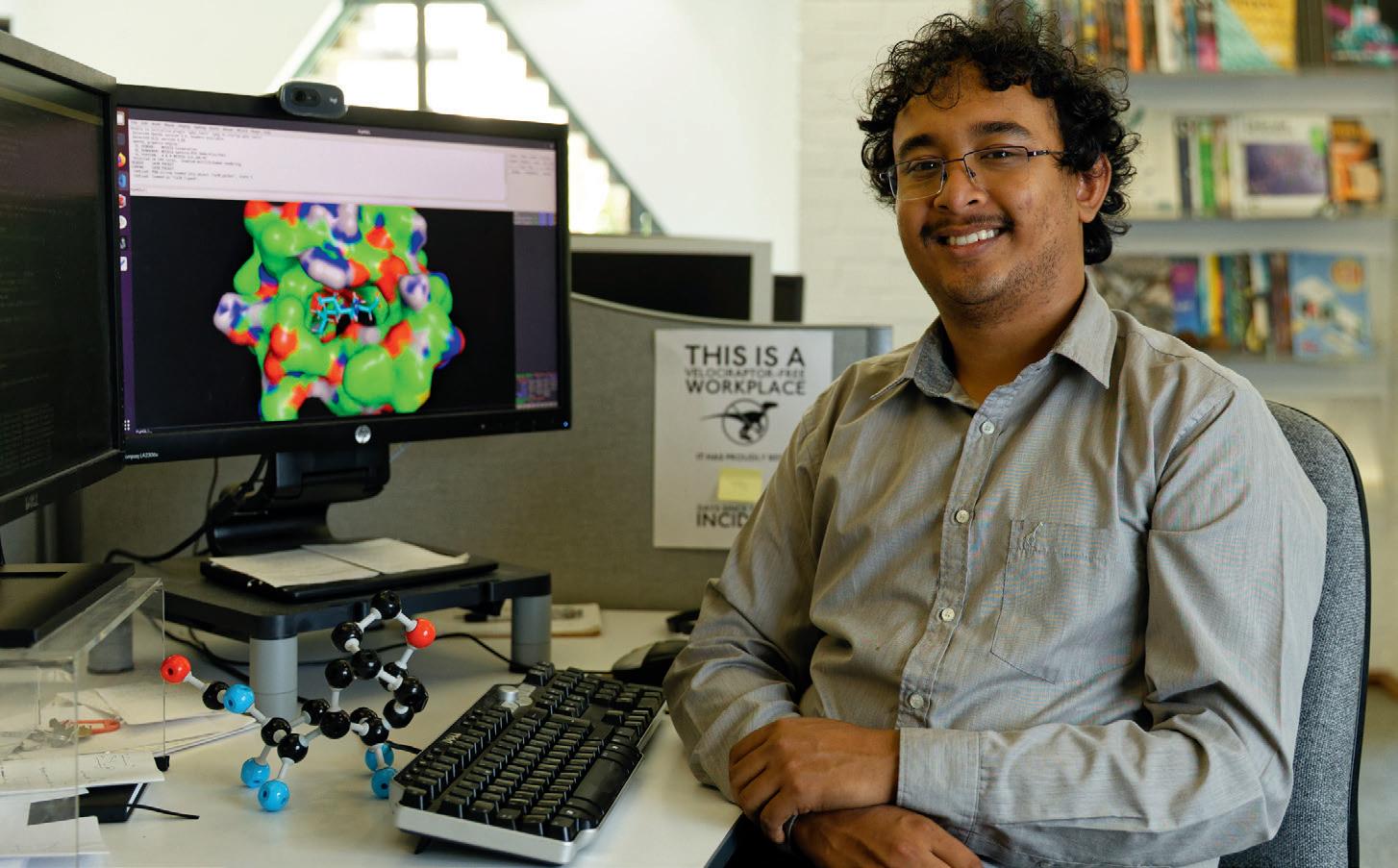
Srijit, who is also a visiting student at the Broad Institute of MIT and Harvard, develops tools for scientists working in drug discovery. He combines drug data and AI to make predictions about how chemical compounds will interact with the body.
AI can identify patterns across vast swathes of data faster and more accurately than the human eye. These new tools will help researchers pinpoint drugs that have a higher probability of safety.
These are some of the potential applications for Srijit’s models, which he has recently published in academic journals.
Predicting how toxic a drug would be
This AI model identifies drugs that may cause damage in the heart. Drugs can
either harm the heart’s structure or alter its rhythmic functions.
Since cardiotoxicity is caused by a huge variety of factors, the model incorporates numerous datasets that record how drugs affect the heart.
“This is a new dataset released by the FDA, and this is the first work that explores how we can use AI to see patterns from a lot of different datatypes,” says Srijit.
This project has the potential to help scientists narrow down their targets when searching for new, safer drugs.
Early Detection of Drug-Induced Liver Injury
Drug-induced liver injury can be a side effect of some medicines, and can be very dangerous. It is difficult to predict
because a lot of different factors come into play around this complex organ. Srijit says: “Liver injury is one of the biggest causes of a drug on the market being withdrawn.
“Liver toxicity is very complicated and is very difficult to predict with just the chemical structure. This model takes the chemical structures and other measured properties to make predictions that can take years using traditional methods.”
Cell health from images
The general health and makeup of cells are critical to understanding how they respond to different drugs. BioMorph makes predictions about how a drug will generally affect the body, using two datasets which have never been combined before.
One set includes detailed cell images that label the size and shape of different features of cells such as the nucleus and mitchondria. This is combined with cell health data that records how different treatments affect cells. Together, these sets predict how a particular drug might affect cells.
Srijit says: “BioMorph groups these two datasets that have never been combined before, so is potentially more interpretive and accessible for biologists.”
Srijit says if potential users are willing to give feedback on how BioMorph validates their findings then to please contact him at seal@broadinstitute.org.
Dr David Wakerley and Dr Sarah Lamaison founded Dioxycle to convert industrial emissions into sustainable commodities. We profiled Dioxycle in the Spring 2022 Chem@Cam and recently caught up with David to find out how the company is doing.

“The past two years have been transformative for Dioxycle,” says David. “We have increased our team from four to 23 (in Paris and San Francisco), scaled our technology from the size of a postage stamp to an oversized suitcase, and have developed key partnerships with industrial leaders committed to pioneering large-scale decarbonisation.”
The company has raised $17.5 million in its most recent Series A round of financing. Funders include the top venture capital firms for climate tech innovations: Breakthrough Energy Ventures (founded by Bill Gates), Lower Carbon Capital and Gigascale Capital.
Catalysing change
Dioxycle’s electrolysis technology converts carbon emissions into sustainable ethylene; a vital ingredient in the production of many day to day commodities, from textiles to plastics
to fuels. The team has developed catalysts which reduce the energy cost of this conversion to make sustainable ethylene at a similar cost to the fossil alternative.
Ethylene, one of the world’s most used chemicals, is currently produced in a carbon-intensive way. “By reinventing the ethylene production pathway from fossil-fuel cracking to carbon emission recycling, our technology has the potential to displace the equivalent of 1% of the world’s emissions,” says David.
“Ultimately, we want to operate our ethylene-producing electrolyser on carbon captured directly from the air or from biogenic sources, creating entirely sustainable chemicals and fuels, but to begin with we are focusing on industrial sectors with concentrated sources of emission, particularly those that would otherwise be hard to decarbonise.”
Sarah and David recently completed two years as fellows in the first cohort of the Breakthrough Energy Fellows program, founded by Bill Gates. The scheme supports climate innovations that have the potential to reduce greenhouse gases by at least 500 million tons per year, with the aim to accelerate development of these technologies to reach net zero emissions by 2050.
“The programme gave us access to top companies who are exploring pathways to produce decarbonised feedstocks,” says David. “There’s an urgency behind what we are doing, and we need to have the right partners with us to accomplish what we want to accomplish: affordable, sustainable ethylene production.”
“Looking forward, we are excited by the work ahead that will bring our first-ofits-kind electrolyser to industrial pilot scale, converting carbon emissions into ethylene with no green premium.”
The company is actively recruiting ambitious researchers, Process and Chemical Engineers and a Head of Finance.


During his long and successful career in Cambridge, Professor Chris Abell demonstrated his wide-ranging talents by taking on many roles including Pro-Vice-Chancellor for Research, first director of the Office of Postdoctoral Affairs, founding director of Cambridge Enterprise (the University-owned company that helps commercialise research), entrepreneur and co-founder of three companies: Astex Pharmaceuticals, Sphere Fluidics and Aqdot.
In this department Chris ran a large and highly successful research group which focused on two separate research areas which he pioneered: fragment-based drug discovery and microdroplets.
Over his career Chris mentored over 160 postgrads and postdoctoral researchers. Now, just over three years after his untimely death at age 62, Chris’ final two PhD students will be submitting their theses. We felt this would be a fitting time to talk to some former group members and discover how working with Chris affected their subsequent careers.
Dr Jing Zhang
Years in group 2009–2012
Jing is Strategy Director at Aqdot, which she co-founded with Chris, Professor Oren Sherman and Dr Roger Coulston in 2012 as a spinout of her PhD research in the Abell group.
Jing was researching microdroplets in collaboration with her husband Roger, a postdoc in the Scherman group. “We ended up making capsules, which was a new thing,” she recalls. “Chris suggested that patenting the work and forming a company would be the best way to develop the technology.”

Aqdot’s patented technology uses cucurbituril molecules with hollow cavities that can bind tightly to a wide range of guest molecules to create capsules, with potential applications in homecare, personal care, automotives and pharmaceuticals. The company recently brought Oderase to the market, which is the first and only fragrance-free air freshener in the UK.
“Chris had an immense influence on my scientific career,” says Jing. “He was one of the best scientists I know and had a huge amount of rigour and creativity. He gave me a lot of guidance and was very patient holding my hand through my first year; but he also knew when to let go a little bit.
He really embraced Aqdot using his scientific ability but also with his commercial knowledge: the three of us were just eager to get published, so if he hadn’t stopped us, there wouldn’t be a company to begin with. He was also a huge supporter for female students and scientists.”


Years in group 2010–2015
Katie is co-founder and Senior Vice President of Ribometrix, a biotech company based in North Carolina whose drug discovery platform develops small-molecule therapies that target RNA to prevent the production of disease-driving proteins.
Katie’s PhD scholarship allowed her to split her time between the Abell group and the National Institute of Health in the US. “My background was and remains in RNA research,” she says. “I had already identified a PI with an RNA structure lab in the US and the Abell group had done research against an RNA target which had paused, so it was like a match made in heaven.”
“Although Chris was very busy, when you met with him you felt that he was really taking the time to think about you, your science and your career. His lab was an amazing group of people, not just because they were super smart, but also because they were so warm and willing to help. You hear that some chem labs are rough on the students, but this was the opposite: it was an awesome environment.”
“Being in Chris’ lab and hearing about his start-ups gave me the courage to co-found Ribometrix. Chris had successfully raised money from venture capitalists and he gave me good advice. He was eager to help – he was so busy and he made the time for me!”
“Professionally, I learned from Chris that you can do really cool science in industry: at that time in my career I didn’t know that yet. I also learned that you can be a rigorous scientist with a productive, successful group and still be a warm and nurturing mentor.”

Professor Alessio Ciulli
Years in group 2002–2010 (with short break in US)
Alessio runs his own research group at the University of Dundee, and he is founder and Director of Dundee’s Centre for Targeted Protein Degradation. He came to the Abell group as PhD student and continued as a postdoctoral researcher until starting his own research group in 2010.
“Chris provided me with freedom to explore ideas. He showed me how to take a rational, practical approach to research and to question assumptions. He used to tell me I had broad shoulders, so I believed him. Because Chris gave me the freedom to operate that I needed and wanted, I learned how important that is to do that with my own group members.
“The things I learned while in his group have underpinned a lot of the pioneering science I’ve been able to do in my own lab independently, including founding my company, Amphista Therapeutics. There is no doubt that I learned a lot during my time with Chris about that connection between industry and academia.
“I learned from Chris how to collaborate, work with others and lead others, which has greatly influenced my academic career. He knew his chemistry but he would never make you feel inferior. He was very down to earth – perhaps down to his roots, he was a Yorkshire man. He enabled me to grow so much as a person and as a scientist.”
Professor Ziyi Yu
Years in group 2012–2020
After completing his PhD at Nanjing Tech University, Ziyi joined the Abell group in 2012 as a postdoc. Ziyi now runs his own research group as Professor of Chemical Engineering at Nanjing Tech, and he is Vice Director of the State Key Laboratory of Materials-Oriented Chemical Engineering.
Ziyi worked in the microdroplets section of the group, researching two distinct areas based on microdroplets: the first was single-cell analysis and screening, and the other was the self-assembly of supramolecular polymers.
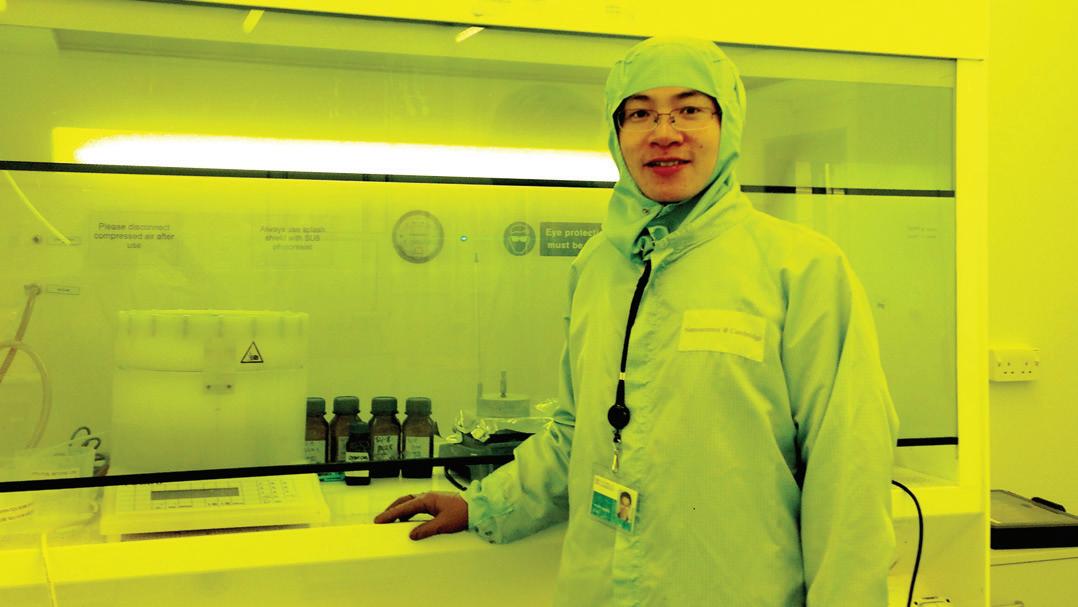
Ziyi working in the clean room.
“When Chris took the position of Pro-Vice-Chancellor for Research [which he held from 2016 until his death in 2020], I was more or less in charge of the management of the microdroplets research,” says Ziyi. “This was a real chance to manage researchers and students, which improved my management skills.
“Chris always shared his wonderful knowledge and resources, ranging from colleagues to postdocs and PhD students, and I really learnt from him that we are a family and we need to help others. Not just in science but how to be a better human and contribute to society.
“Chris had interests that spanned beyond research to include the lifestyle and culture of Cambridge. He gave me the courage to explore Cambridge life and to learn about western culture.”
Anthony Coyne Years in group 2008–2023
Anthony, who is now a Senior Scientific Associate at Cancer Research UK, came to Cambridge in 2006 as a postdoc for Professor Martin Smith and was subsequently hired as a postdoctoral research associate by Chris when Martin moved to the University of Oxford. When Chris became the PVC for Research in 2016, Anthony helped run the group for five years until Chris passed away in October 2020. He subsequently ran the group until it wound down in 2023. Anthony is helping the group’s final two PhD students submit their theses.
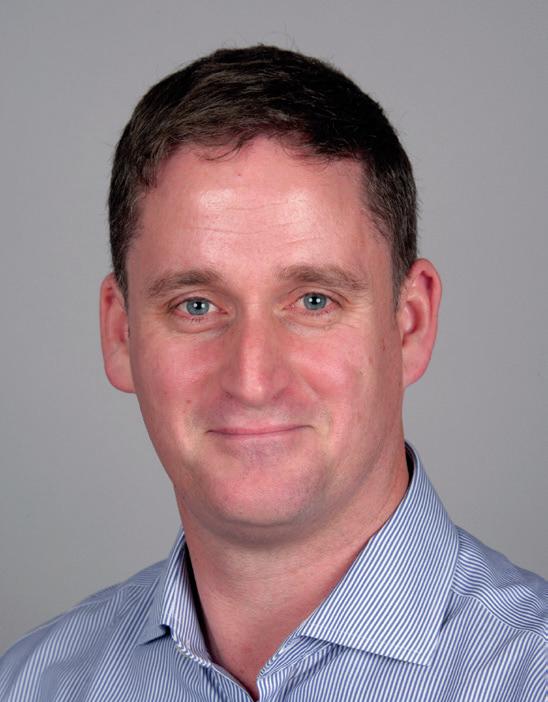
“Chris was a very busy man. He did not micromanage, however if you wanted to discuss any aspect of the research, he always made time to share his knowledge. It was a steep learning curve for anyone joining his group
because we were not just focused on one aspect of drug discovery but the many parts of this. It was a highly multidisciplinary, collaborative group with a wide range of interests, which really sums up what Chris was about.
“Katherine [see below] dealt with a lot of the administration around the grants and we worked closely together to ensure the smooth running of the group. I was very fortunate to work with a large number of summer students, Part III students, MPhil and PhD students and postdoctoral researchers, all of whom contributed to the highly engaging environment that was the Abell group.
“My own PhD was in the area of physical organic chemistry, which was very different from the work carried out in the Abell group. I was influenced by the research carried out in the Abell group focusing on the wide range of aspects of drug discovery and as a result, I am now involved in cancer research drug discovery.”
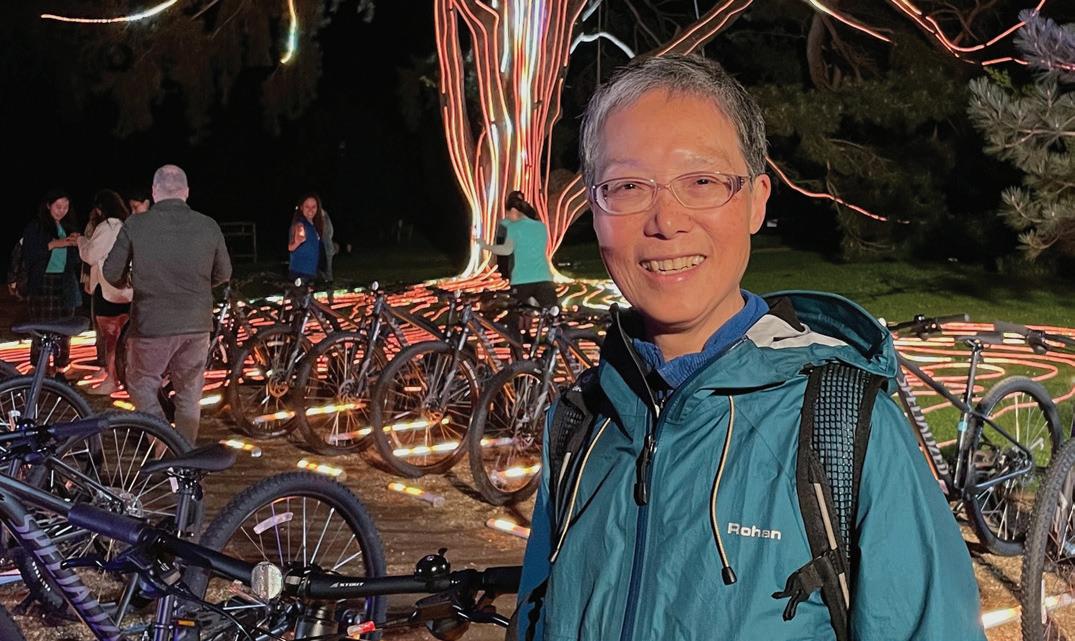
Katherine Abell Group administrator 1998–2023
Katherine was a PhD student in Tony Kirby’s group when she met Chris, who was completing his PhD with Jim Staunton. They were married in their second year and lived in college accommodation on Brookside, a stone’s throw from the department.
After working in the private sector and for the Department of Engineering, Katherine returned to Chemistry to help Chris set up his new microdroplets research group, the first of its kind in the department. Lots of new equipment needed to be purchased to set up the microdroplets lab from scratch. She helped Chris manage the research funding and recruited the researchers, eventually staying on as Research and Facilities Manager for the Abell group, encompassing Chris’ interests in both the fragment-based drug discovery and microdroplets research areas for 17 years.
Katherine says: “It was an honour and a privilege to have been part of this extended family. A well-run lab requires
not only the ideas and talented researchers working through projects, but all the other people, including the technicians, computer officers, grants administrators and the cleaners. I’ve had so many wonderful colleagues over the years.”
When asked to sum up Chris’ best qualities, Katherine sets out this list: a visionary who could see the bigger picture, a clear thinker, a believer in collaborative research, a leader who inspired and energised those who journeyed with him, a quiet revolutionary, a warm and kind-hearted human being.
Katherine retired in 2023. She is a keen gardener and volunteers at the Cambridge University Botanic Garden. Her plans for the future are: “To find peace in a new life and to continue to grow and be a better version of myself.”
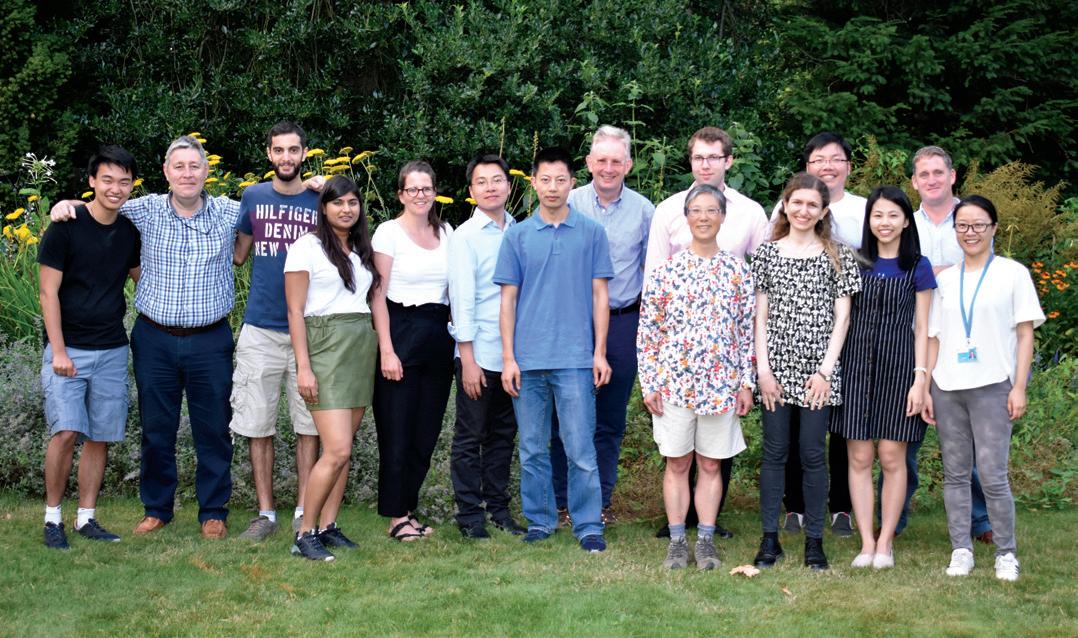
It is impossible to mention all of the Abell group members, a high proportion of whom have gone into academia and many who unsurprisingly have also become entrepreneurs. In our own department, Professor Sir Shankar Balasubramanian was one of Chris’ early PhD students. Others have excelled in fields outside of Chemistry, such as Xerxes Mazda, who is currently Head of Collections and Curation at the British Library.
But perhaps Katherine best sums up Chris as a person when she says: “He didn’t make a distinction between work and nonwork – he only had one thing, which was life.”
Katherine cycling at the Botanic Garden for the King’s coronation. Abell group summer party at Christ’s college 2019.
For the second year running, the department hosted the Black Women in Science Network’s Brunch Talks LIVE!
Oluwatomi Akingbade founded the Black Women in Science Network (BWiS) in 2018 when she was still an undergraduate at the University of Nottingham, to give black women in science a platform to meet and share their experiences.
Tomi, who is now a third-year PhD student in the Klenerman group, studies aggregates that cause inflammation and degeneration in the brain which could underlie Parkinson’s and Alzheimer’s diseases.
“I’ve always loved science, and creating BWiS was a way for me to feel confident in my right to take up space in science. Our live brunch talks are a physical space where we can recharge and connect with people who have had a similar path.”
It was great to see so many new faces this year, and I’m grateful to the Department of Chemistry who gave us this space to gather, recharge and reignite our joint passion for science.”
“Brunch Talks Live! are a physical space where we can recharge and connect.”

Over 40 women from many different scientific fields attended the event, which was held this year in the Cybercafé. Amen Eghosa-Aimufua, BWiS Events Officer and final year trainee Clinical Psychologist says: “This was my first time supporting the network to host Brunch Talks LIVE!, and it was such a joy to be a part of it.”
A highlight of the brunch was the keynote speech delivered by Dr Tamara Mulenga Willows, a medical doctor and academic fellow at Queen Mary University of London, who talked about the challenges and triumphs of her research on avoiding preventable deaths during the COVID-19 pandemic. She also shared more personal insights on overcoming imposter syndrome and navigating the intricacies of academia, which resonated with the audience.
In addition to the delicious food, there were lots of opportunities to network and share experiences. “I was grateful to see so many black women connecting over shared interests and experiences, whilst thoroughly enjoying themselves!” says Amen.
“We couldn’t do this without the support of our members and sponsors the Department of Chemistry, the Academy of Medical Sciences and the Royal Society of Chemistry. We absolutely encourage such institutions to seek out and support the curation of similar events.”
A crucial role
“These events play a crucial role in rejuvenating black women in the scientific field and offering respite from the burnout often induced by academic, professional and sociocultural pressures.”
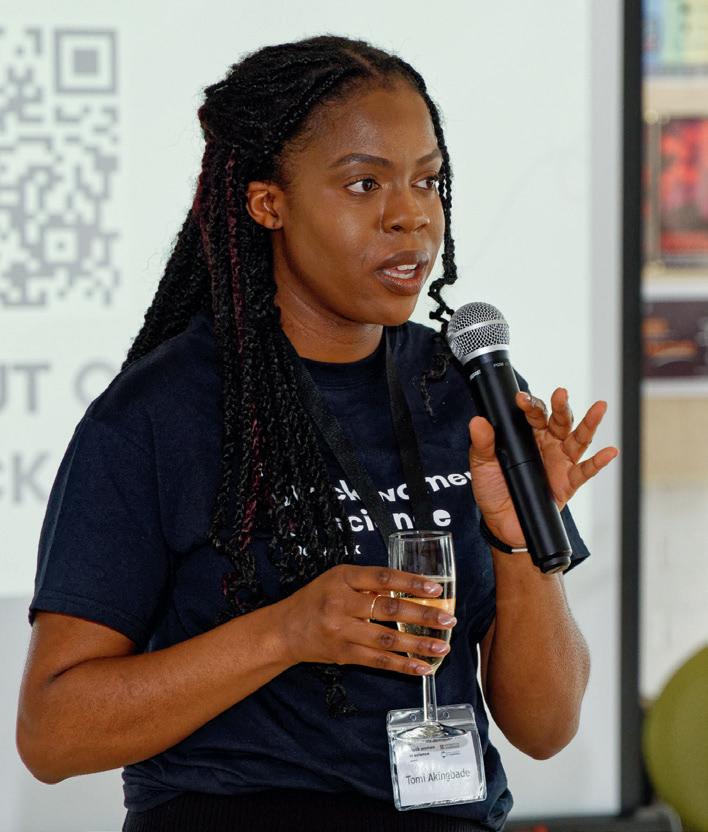
Deputy Head of Department Dr Nick Bampos says: “After the excellent event last year we were keen to help Tomi hold another networking event in the department and to support the excellent work she does to encourage, inspire and support a generation of young black women scientists.”
The Black Women in Science Network serves as a testament to the importance of creating spaces where black women in science can thrive and succeed. To find out more, visit www.bwisnetwork. co.uk. Membership is free.
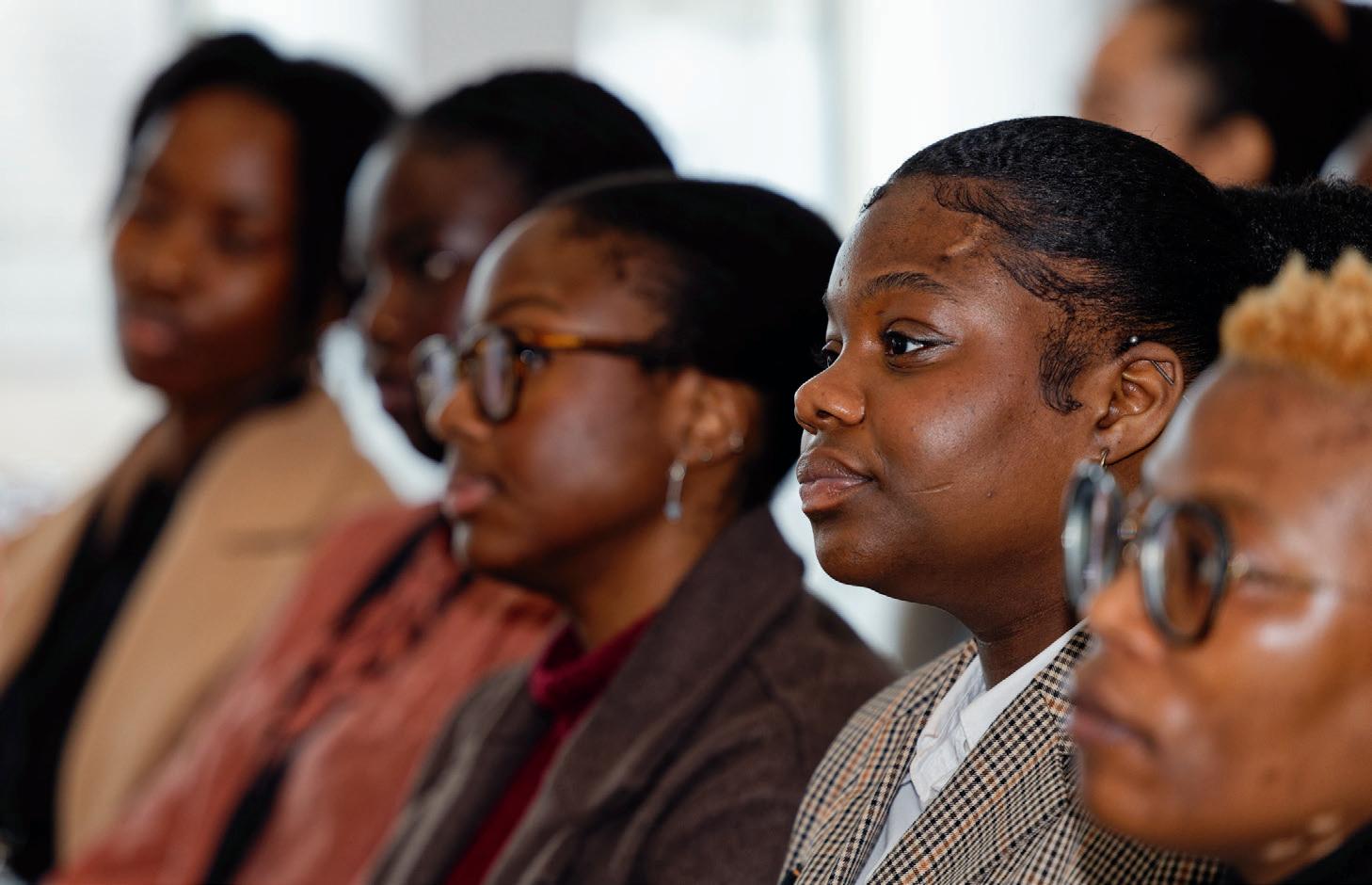
DrZenon Toprakcioglu is a Ron Thomson Research Fellow in Alzheimer’s Disease, who studies protein misfolding diseases in the Knowles group. Here he tells us about his latest research into how lipids found naturally in our cells and in the brain’s grey matter could slow down the formation of protein aggregates.
Clumps of the aggregated protein amyloid-beta (Aβ) have long been associated with Alzheimer’s disease. These aggregates, also known as amyloid fibrils or amyloid plaques, accumulate in the brain over time and eventually lead to neuron death.
We don’t know why these aggregates form, but one hypothesis is that lipids and lipid membranes can affect their formation. In fact, increasing evidence suggests that lipid membranes play a critical role in regulating protein function. This means that malfunctions in lipid composition could have a direct effect on proteins and possibly result in the promotion of toxic protein states.
Gangliosides are a type of lipid, or fat, which are abundant in the brain and are essential for cell communication and signalling. They have also been associated with neuro-protection and neuro-restoration. Ganglioside lipids are mainly found in the outer layer of the cell membrane, which is the part that is in contact with the extracellular environment and with the amyloid-beta protein.
Because of their location and the fact that the number of ganglioside lipids decreases with age, we wanted to
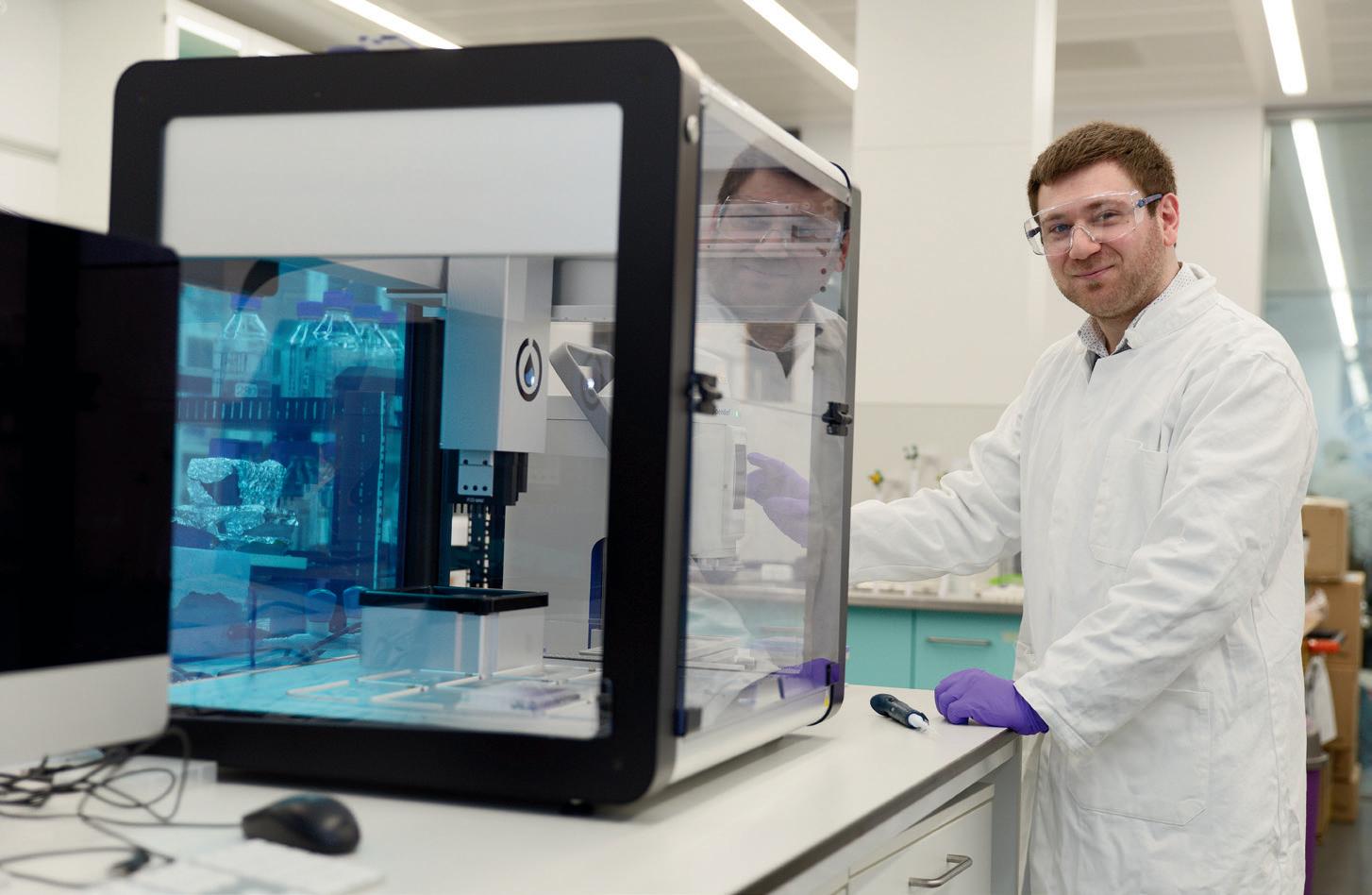
investigate the role (if any) they have on the aggregation of amyloid-beta toxic protein states.
For this project, we used complex kinetic experiments and theory to investigate the interaction between ganglioside lipids and the two most abundant forms of amyloid-beta (Aβ42 and Aβ40). We discovered that ganglioside lipids have the ability to completely inhibit the aggregation of Aβ40 and partially inhibit the aggregation of Aβ42. Through our experiments, we were able to show that gangliosides can form complexes with the proteins which disrupt the
aggregation pathway and result in delayed aggregation.
We believe that through further in-depth experimentation, we can achieve a fundamental understanding of what happens during interactions between proteins and lipids in neurodegenerative disease. My aspiration is that this line of investigation will pave the way for the identification of new molecular targets involving lipids, which could lay the foundation for new therapies in the fight against neurodegenerative disorders. In the long-term, this will hopefully improve the lives of people suffering from these ailments.
Zenon Toprakcioglu, Akhila K. Jayaram, Tuomas P. J. Knowles, Ganglioside Lipids Inhibit the Aggregation of the Alzheimer’s Related Peptide Amyloid-β, bioRxiv preprint server (2023).
Dr Leila Nahidiazar and PhD student Bin Fu work in Professor Steven Lee’s group. Leila interviewed Bin for this article about the experience of being a newcomer to Cambridge.
Third-year PhD student Bin Fu studies Parkinson’s disease and its progression. Alongside labelling proteins and optimising code Bin, who is from China, is also navigating his PhD from an expat’s perspective.
What excites you the most about your work?
One of the aspects that excites me most about this project is its multidisciplinary nature. Working at the intersection of chemistry, engineering, and neuroscience, I find myself learning something new every day.
I regularly present findings to teammates and collaborators with diverse backgrounds so I’ve learned to convey complex ideas in a clear and accessible manner.
Do you have any clear memory of the first days you came here?
The first day of my arrival in Cambridge was a bit challenging. Moving into my new accommodation proved to be a complex task, as my residence was not within my assigned college but in another. It was not fun, but it has become a memory now!
What do you think of Cambridge as a city?
It is fascinating that everyone has a different response to this question! A lot of people come to Cambridge from elsewhere which leads to unique perspectives.
Beyond the university walls, one of the most exciting aspects for me about the city is the various international cuisines, from authentic African dishes to Japanese food. The variety is not only delightful for the taste buds but also provides a unique opportunity to learn about different cultures.
What was your biggest cultural shock?
One notable example that struck me was the varying perspectives on movies, TV shows, and cartoons. Coming from a different cultural background, I quickly discovered that what may be a cultural touchstone for one person might be entirely unfamiliar to another.
I found myself in situations where references or jokes were lost in translation, and vice versa. While this initially presented a cultural shock, it became a source of mutual learning and appreciation. An illustrative
instance occurred when my supervisor attempted to convey the essence of our project using a reference to the movie The Matrix. However, it took me some time to grasp the intended analogy, as I was not familiar with English movie titles.
Do you see yourself staying in Cambridge for a longer time?
Though I remain open to the possibility of staying in the UK, my future plans lean towards returning to China. This is mainly because of the bonds with my family members and my girlfriend. Moreover, integrating into a new cultural context for a long term can be demanding.
Leila is a Senior Research Associate investigating the design and uses of superresolution microscopy. In her free time she is a writer and poet. She has published two novels in Persian and has worked as a columnist for UTNieuws in the Netherlands. Leila grew up in Iran and lived in the Netherlands before arriving in Cambridge.

Ateamof researchers has found a new way to simplify the structure of high efficiency blue organic lightemitting diodes (OLEDs), which could lead to longerlasting and higher definition television screens.
OLEDs are a class of organic electronics that are already found commercially in smartphones and displays and can make energy generation and consumption more efficient. Although OLED television screens have vivid picture quality, they have certain drawbacks such as high cost, high energy use and comparatively short lifespans.
In a paper published in Nature Materials, the researchers from the universities of Cambridge, Imperial, Loughborough and Northumbria describe a new design which overcomes these issues and may lead to simpler, less costly systems with purer and more stable blue light.
Screen pixels are composed of three different coloured subpixels – red, green and blue – that light up at different intensities to create different colours. However, the subpixels that emit blue light are the least stable and can be susceptible to screen “burn-in,” which can discolour the screen and ruin viewing quality.
Although some progress has been made to optimise blue OLEDs this new discovery is simpler, more stable and less expensive.
“OLED screens have great picture quality and carry a high premium. However, OLED TVs don’t last as long as other screens. Pixels that emit blue light are essential for a practical display but are also where the problems lie,” says Dr Daniel Congrave, who recently completed a Herchel Smith Fellowship in organic chemistry, and is now an independent researcher working in Professor Hugo Bronstein’s research group.
An OLED is built like a sandwich with organic semiconductor layers between two electrodes. In the middle of the stack is the emissive layer, which lights up when powered with electricity. Electrical energy goes into the molecules in a process called excitation. The excited molecules then release this extra energy as light.

An ideal OLED turns most of the electric energy into light but sometimes the energy gets clogged and cannot be released as light. In this instance, this energy still needs to be released somehow and degrades the structure of the OLED. This reduces the OLED efficiency and lifetime and is especially a problem with blue light.
A new molecule
Congrave and Bronstein decided to design a new light emitter to solve this problem. The design of efficient OLEDs comes down to managing how the structure of an OLED can channel energy constructively.
The emitter in the OLED they designed in this research can selectively choose which energy it uses and blocks the destructive energy. The imaginative leap was to add shields to the emitter which controls how the molecules interact.
“We’ve designed a terminal emitter molecule that’s enabled us to block the transfer of triplet states, allowing us to simplify the device structure of the blue pixel to only two components, while maintaining high efficiency,” says Daniel. “The molecule we describe in this paper is also one of the narrowest emitting blue molecules out there, which is very useful for screens because it allows for high colour purity.”
PhD student Lucy Walker is jointly supervised by Professor Hugo Bronstein and Professor Sir Richard Friend in Physics. Lucy is researching the design and synthesis of organic radical molecules that can absorb and emit light, which could one day be used for OLED screens and solar panels.

“Manufacturers are interested in OLEDs because they are more efficient and afford superior display quality compared to other lighting technologies,” she says.
As part of her research, Lucy is involved in the synthesis of small molecules. “A great aspect of my day is that the dyes I make are very beautiful colours. I have bright pink, red and green ones at the moment. My goal is to make them more efficient at emitting light whilst retaining their molecular stability.”
in honey. I’d recently read an article about the science of honey and it all just clicked.”
Her largest project was a commission for the University of Birmingham of their iconic clocktower ‘Old Joe’, using molecules that have been researched in their chemistry department. It took her over 100 hours to complete and will be featured at the University later this year in their new chemistry building.
Hwan-Hee Cho, Daniel G. Congrave, Alexander J. Gillett et al., Suppression of Dexter transfer by covalent encapsulation for efficient matrix-free narrowband deep blue hyperfluorescent OLEDs, Nat. Mater. 23, 519–526 (2024) https://doi. org/10.1038/s41563-024-01812-4.
Away from the lab, Lucy creates pointillism-inspired art using skeletal molecular structures. For many years she specialised in photorealistic drawings but during lockdown was inspired by her father to try something different. Lucy reached to chemistry for inspiration, and the pieces naturally fell into place.
“The insect I chose to draw first was a bee, using glucose, fructose, gluconic acid and hydrogen peroxide molecular structures, which are all molecules found
See Lucy’s Instagram account @_molecularts.

We are changing preconceived notions of the ‘traditional Cambridge student’ by recruiting students from a much wider range of backgrounds and experience. And it’s good for science too.

“The great thing about Cambridge is that wonderful students beat a path to our door. But there are lots of fantastic students who either don’t know about us or think we wouldn’t be interested in them – we want to find them and encourage them to apply here,” says Head of Department Professor James Keeler.
Recruiting postgrads from ‘outside the bubble’
The department has been working with the University to encourage students from traditionally underrepresented backgrounds to apply for postgraduate research programmes here.
Professor Deborah Longbottom, Director of Education for the School of Physical Sciences and Head of Postgraduate Education here, says: “It is important that everyone who has the capability to thrive at Cambridge should be given a chance, and we have been working hard to make sure this can happen.”
Most potential postgrads are evaluated solely by their academic achievement. This scheme aims to overcome this inherent bias by adding context to applications such as caring responsibilities, being the first generation to go to university or bereavement during exams.
Postgraduate Student Coordinator Tessa Blackman, who manages postgraduate applications in Chemistry, says: “Using the contextual admissions form helps eliminate in-built disadvantages, because it allows us to tease out key information from a student’s application which is more reflective of their potential.”
The PUF helps find UK applicants who meet widening participation criteria and have not previously studied at Oxford or Cambridge.
It highlights applicants who belong to groups that are particularly underrepresented in postgraduate study, such as those who have been in care, were eligible for free school meals or had caring responsibilities.
Close the Gap is aimed specifically at increasing the representation of British Black, Bangladeshi and Pakistani students in postgraduate research at Oxford and Cambridge and to halve the current offer gap in the pilot sites by the end of 2025. They also run a free, online programme called AIM PhD, which provides mentoring to those applying for a PhD in Chemistry.
Project coordinator Tanne Heathershaw says: “Widening participation is about the elements of fairness and justice in admissions, which means that reasons out of your control shouldn’t affect your opportunity to be studying at Cambridge or Oxford.”

Melina von Wenczowski is a visiting student from Germany working in the Vignolini group. She provides a glimpse into her time navigating both the scientific landscape in the department and the rich tapestry of her host city.
When I visited Cambridge for the first time in 2018, I was standing on King’s Parade and caught the vibe of the city. I knew I wanted to study here, but I soon realised that I would not be able to pay the student fees, and EU scholarships were uncertain after Brexit.
So I started my degree at the Ludwig Maximilian University of Munich, and somehow now this dream of studying at Cambridge has become real: As a visiting student in the Vignolini group I am engaging in lab work and writing a thesis for my Master’s of Science at LMU.
My research
I came to the Vignolini group to research structural colouration. Unlike pigment, structural colour is the result of light interacting with material structured on a submicroscopic scale. It is often found in nature and serves as inspiration for materials research. In my project, I work with a suspension of small cellulose particles in water. I am investigating their behaviour upon drying to further understand their colourexhibiting properties.
I came because of the science (and crumpets) and because
I love being in the labs. It is interesting to see how bad my English becomes as soon as I have to name chemical equipment! And it is fascinating how lab work in other places can look so similar and so different at the same time.
Visiting student
Being in Cambridge, especially as a visiting student, is a unique experience. Everyone who has been to the department knows its quirks and its charms, such as needing to look around the weirdest corners to find offices or even lecture theatres.
One especially interesting novelty for me was the sustainability initiative around nitrile gloves. Before coming to Cambridge, I used to dispose of them in big blue chemical waste bins along with all my chemicals. Here, the gloves are recycled and can be reused in another way.
In Cambridge I have seen beautiful old college buildings, wandered the paths of my scientific role models and learnt about their history. It is easy to be immersed in the science creativity happening everywhere in Cambridge and I will keep these memories very safe.
Matt Bushen started working here in 2000 during the last year of his apprenticeship as an electrician. After a short stint on the Addenbrooke’s site, he returned to Lensfield road and is a cornerstone of the department as the Facilities Manager.
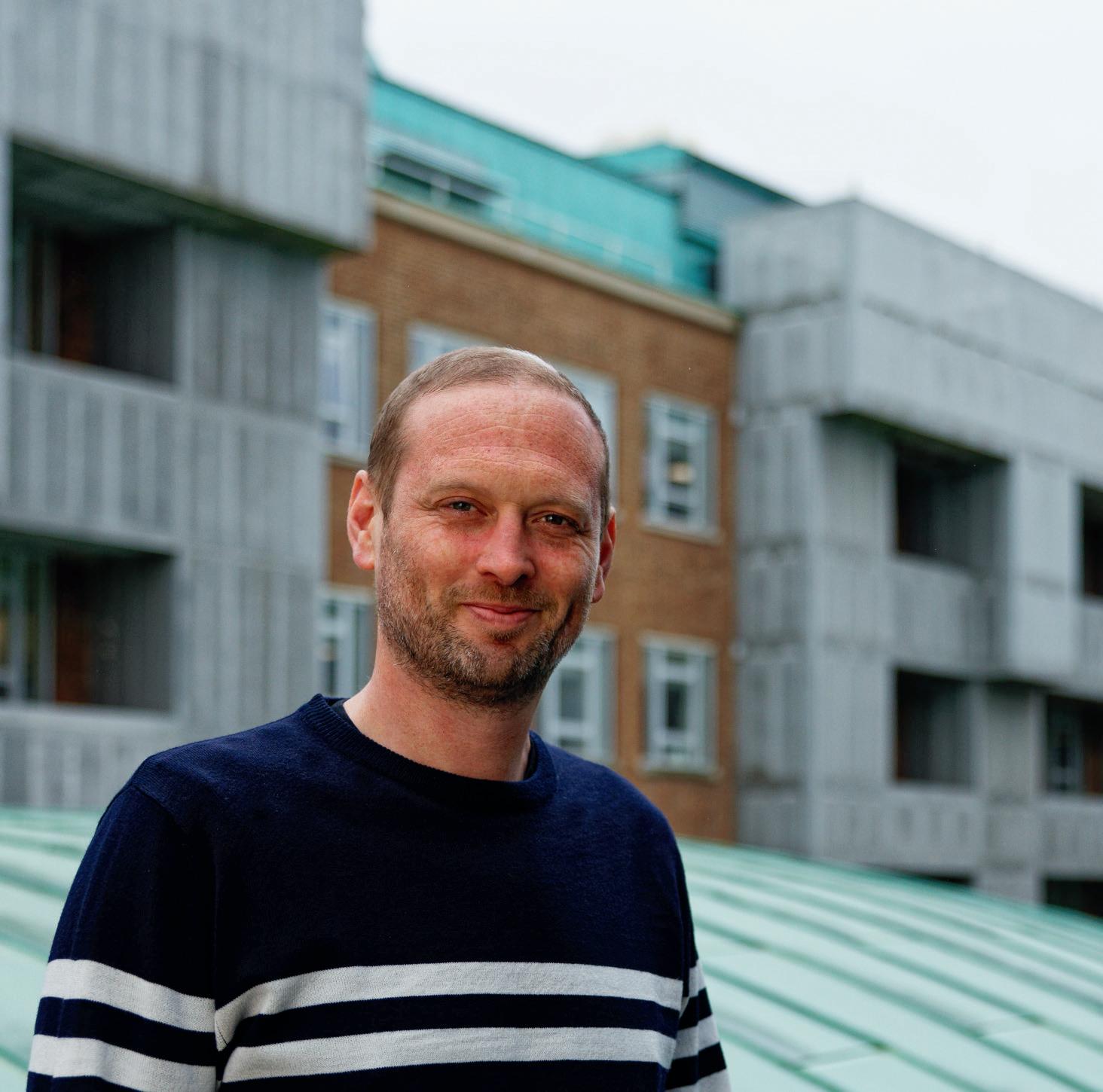
Is there a typical day for you?
Typically not, and that’s what I like about it. I manage a team of seven people and any facility-related contractors on site. Basically, the in-house maintenance team try to keep everything running, whether that be the air extract for the fume cupboards, or the plumbing. If we can’t for any reason, I refer the issues to the University Estates Division, Equans. I then spend a great deal of time chasing jobs up to ensure they are completed!
When I first arrived in 2000 it was to a huge departmental refurbishment project which involved the maintenance
team. Now, two decades later, I’m not only in charge of small refurbishments but also involved in major, sometimes multi-million-pound lab refittings where we update the wiring, fume cupboards, everything. These should have a positive impact on efficiency and sustainability.
What are the must-have tools you rely on that people might not immediately know about?
Well, I’ve got my radio on me at all times to be on call for emergencies, which could be for anything from lights not working during an exam or a leak in the
building, but when I started it used to be a pager. I’d get a page with the room number and that was it. I’d sort out whatever situation I arrived at.
Another surprising one is my bird’s eye map of the department – I just keep it on the wall in my office. Contractors or even people who’ve worked here for years can get disorientated and it’s easiest to point to exactly where we are in the building.
Does the building itself have a personality?
Yes. It can seem chaotic if you are not familiar with it. When new people arrive it’s a maze. It does occasionally happen that I walk into a room that I didn’t know was there.
The department has very complex building needs with lots of differing services and is difficult to maintain. It’s great that a lot of the maintenance team has been here for a long time, so we know the place and its foibles very well. In fact, Richard Preston who trained me is still here.
At this moment, a contractor knocked on the door and brainstormed with Matt regarding the precise route of some wiring within the building.
What do you do in your free time?
I played football for most of my adult life and more recently I have taken up golf, which is a bit more leisurely. I also love to go to live music gigs and festivals. I was a child of the nineties so I grew up with Nirvana, Pearl Jam and Smashing Pumpkins, who I am going to see later this year.
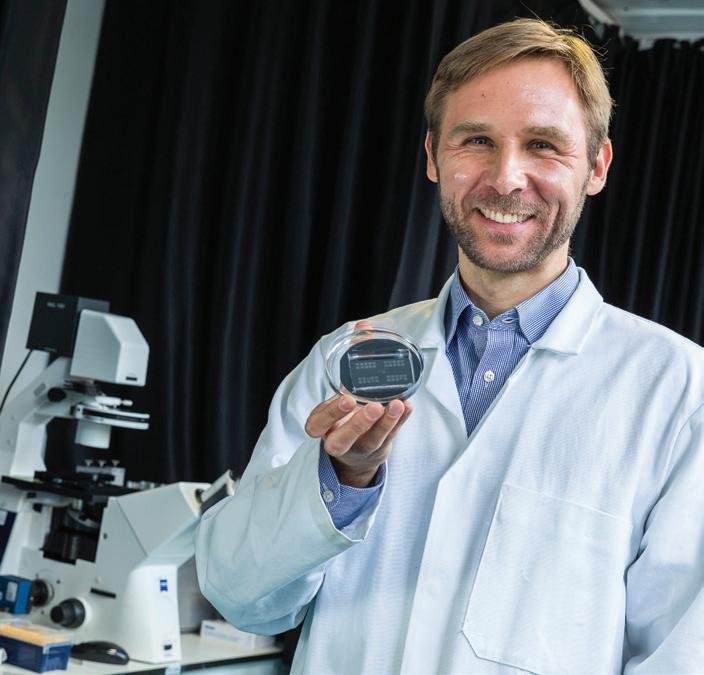
Professor Tuomas Knowles has been awarded a $3.5 million grant from The Michael J. Fox Foundation to develop a platform to diagnose early-stage Parkinson’s. “The platform we’re developing will not only enable early diagnosis of the disease, but will hopefully also allow researchers to track and monitor disease progression.”

Professor Erwin Reisner has been awarded a prestigious £2.5 million Royal Academy of Engineering Chair in Emerging Technologies which will enable his group to focus on their tenyear mission to develop solar chemical technologies to enable lab-to-market transition, a crucial step in the drive to a carbon neutral economy.

Professor Gonçalo Bernardes has been appointed as a Visiting Professor at Xi’an Hospital of Traditional Chinese Medicine in China, where he will continue his research into targeted cancer therapeutics in collaboration with medics and clinicians trained in both Chinese and Western medicine.

Welcome to Professor Erin Johnson, the Lennard-Jones Centre and Royal Society Wolfson Visiting Professor. Erin is the Herzberg-Becke Chair in Theoretical Chemistry at Dalhousie University in the United States. She will be visiting the department over the next two years with the aim of developing fruitful collaborations.

Scientists gathered for the IUPAC Global Women’s Breakfast in the Cybercafé where women in the department showcased their research papers, fostering vibrant discussions and networking opportunities. This year’s theme was “Catalyzing Diversity in Science” to help overcome barriers to gender equality.

A team of four researchers from the Gaunt group was awarded first prize in the SCI National Retrosynthesis competition in March. Retrosynthesis is a framework used by organic chemists to plan synthesis of target molecules by ‘working backwards.’ Second-year PhD students Ryan Kang, Markus Böcker, Russell Woodger and postdoc Dr François Richard made up the team.
We always love to hear from our readers, please tell us what you think!
From Dr Philip Evans OBE (Churchill 1967)I was sorry to read of Brian Thrush’s death in the last edition of Chem@Cam [Winter 2023 Issue 67]. He was, I suspect, the last former lecturer known to the Part II chemists of the classes of the 1960s. I remember his lectures on statistical mechanics for Part II with a sort of horrified clarity.
You also included the obituary of Malcolm Gerloch, who moved to Lensfield Road with Professor Jack Lewis when Jack replaced Harry Emeléus as Professor of Inorganic Chemistry in 1970.
The juxtaposition of these names reminded me that I met Prof Emeléus when he asked to see me in the summer of 1970 after the Part II results came out. He knew I was off to do a PhD at Imperial with Geoff Wilkinson, whom he knew well, and wanted to talk to me about the next phase of my own studies.
I have never forgotten Prof Emeléus’ kindness in taking the time to talk to a callow Part II student who was about to leave to another university. Jack Lewis and Geoff Wilkinson were also so much more than simply brilliant chemists.
I remember them all with great affection. Great scientists can be wonderful human beings too.
With best wishes,

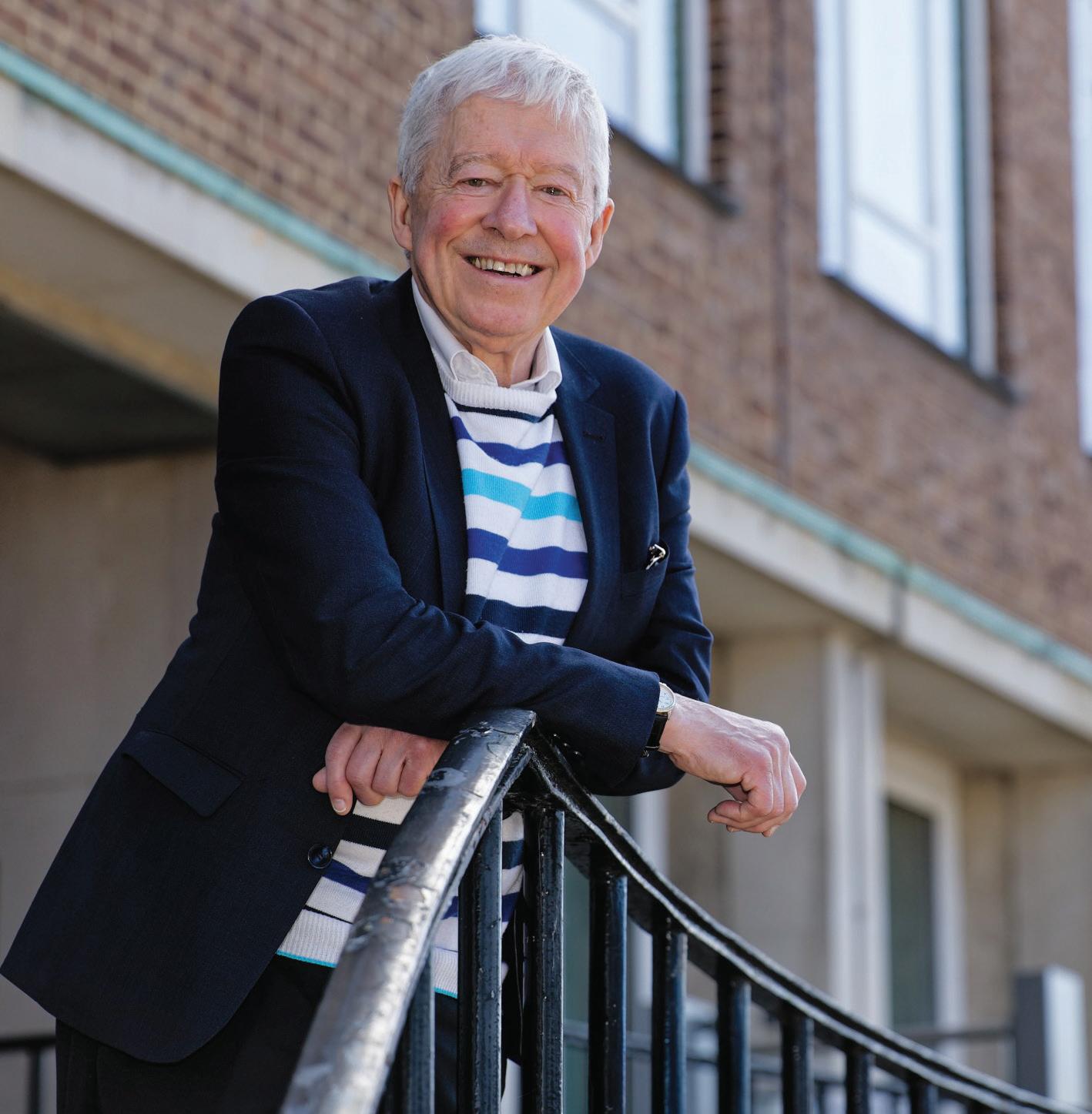
Philip read Natural Sciences at Churchill and completed his PhD in inorganic chemistry at Imperial College. He was Headmaster of Bedford School for many years and received an OBE for his work as a government adviser on education. He now resides happily in Monthelie, France, but still finds time to return to the department occasionally.
Thank you to everyone who responded to our reader survey and for your kind comments about Chem@Cam, which readers seem to enjoy!
People said what they like best are stories about former teachers and professors, and hearing what former colleagues are doing. They also loved the return of the crossword! Many readers don’t like the carbon footprint of a printed magazine, so as a result of your feedback we are looking into ways to circulate a digital version for those who prefer this option. We always welcome your comments at news@ch.cam.ac.uk.
Challenge yourself with a cryptic crossword designed by Loris Marcel, a PhD student in the Zhang lab. He researches how electrons move inside coral cells to determine what happens during bleaching.
When coral cells are stressed, such as when the temperature of light conditions of the ocean changes, they expel the algae that normally lives in the coral. This turns the coral white instead of healthy, vibrant colours and makes it susceptible to disease. Understanding how bleaching occurs at the molecular level could lead to solutions to protect coral from climate change.
Across
1. Need to vent... could be toxic (4)
3. Compound found in chalky nephrite cores (6)
6. Molecules derived from blended scarab meat (10)
8. Loyal mix of metals (5)
9. Clark Kent’s inner animal (4)
10. Fertiliser? Sounds like a French fake party (9)
13. Broken anthracites college (2, 9)
15. Secret ingredient in face toners (7)
16. Workplace removes coloration around collaboration (3)
Down
1. Unit of research assistants caught in fad (5)
2. Drink made of americium, hydrogen and cobalt (5)
4. Wipe inside of black imager (3)
5. Conducts through select rodents (9)
7. A soup of oxygen, rhodium and terbium (5)
9. Cuts less around charged molecule (7)
10. Adjust pleats for subdued colour (6)
11. Predator in Mallorca does computational quantum chemistry (4)
12. Return pad in Austria to acclimatize (6)
14. Attacking without giant (or rather small) nail (4)
Win a prize


Send a photo of your answers by 31 June to crossword@ch.cam.ac.uk for a chance to win a sustainable Yusuf Hamied Department of Chemistry travel mug. The first correct answer to be drawn after the deadline will win.
Answers will be sent out in our Summer alumni email. If you don’t receive our emails, please make sure you’ve opted into receiving emails by logging into the University of Cambridge alumni website (www.alumni.cam.ac.uk).
Congratulations to Evert Ditzel, the winner of the Winter 2023 crossword.

Many students never have the opportunity as undergrads to participate in first-class research, which can hurt their chances when applying for postgraduate courses at Cambridge.
To overcome this in-built disadvantage, the Schools of the Physical Sciences and Technology have set up ten paid summer internships for undergrads from disadvantaged or underrepresented backgrounds, to give them the confidence and experience they need to successfully apply for a postgraduate degree here.
You can help us to promote these and other widening participation schemes by supporting Chemistry.
Contact Head of Department Professor James Keeler for further information on how you can help.